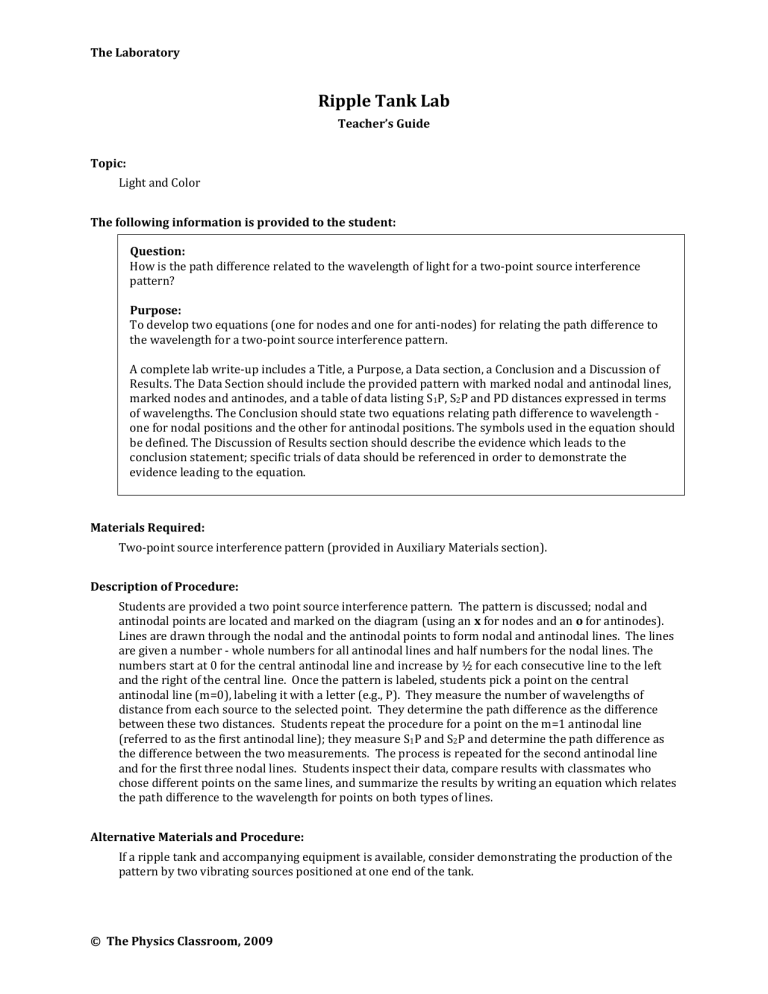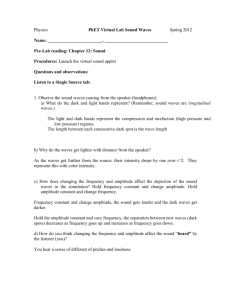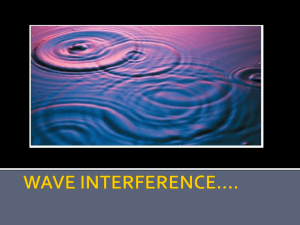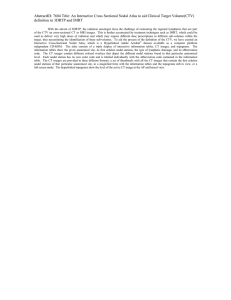Ripple Tank Lab

The Laboratory
Ripple Tank Lab
Teacher’s Guide
Topic:
Light and Color
The following information is provided to the student:
Question:
How is the path difference related to the wavelength of light for a two-point source interference pattern?
Purpose:
To develop two equations (one for nodes and one for anti-nodes) for relating the path difference to the wavelength for a two-point source interference pattern.
A complete lab write-up includes a Title, a Purpose, a Data section, a Conclusion and a Discussion of
Results. The Data Section should include the provided pattern with marked nodal and antinodal lines, marked nodes and antinodes, and a table of data listing S
1
P, S
2
P and PD distances expressed in terms of wavelengths. The Conclusion should state two equations relating path difference to wavelength - one for nodal positions and the other for antinodal positions. The symbols used in the equation should be defined. The Discussion of Results section should describe the evidence which leads to the conclusion statement; specific trials of data should be referenced in order to demonstrate the evidence leading to the equation.
Materials Required:
Two-point source interference pattern (provided in Auxiliary Materials section).
Description of Procedure:
Students are provided a two point source interference pattern. The pattern is discussed; nodal and antinodal points are located and marked on the diagram (using an x for nodes and an o for antinodes).
Lines are drawn through the nodal and the antinodal points to form nodal and antinodal lines. The lines are given a number - whole numbers for all antinodal lines and half numbers for the nodal lines. The numbers start at 0 for the central antinodal line and increase by ½ for each consecutive line to the left and the right of the central line. Once the pattern is labeled, students pick a point on the central antinodal line (m=0), labeling it with a letter (e.g., P). They measure the number of wavelengths of distance from each source to the selected point. They determine the path difference as the difference between these two distances. Students repeat the procedure for a point on the m=1 antinodal line
(referred to as the first antinodal line); they measure S
1
P and S
2
P and determine the path difference as the difference between the two measurements. The process is repeated for the second antinodal line and for the first three nodal lines. Students inspect their data, compare results with classmates who chose different points on the same lines, and summarize the results by writing an equation which relates the path difference to the wavelength for points on both types of lines.
Alternative Materials and Procedure:
If a ripple tank and accompanying equipment is available, consider demonstrating the production of the pattern by two vibrating sources positioned at one end of the tank.
© The Physics Classroom, 2009
The Laboratory
Safety Concern:
There is always a higher than usual level of risk associated with working in a science lab. Teachers should be aware of this and take the necessary precautions to insure that the working environment is as safe as possible. Student horseplay and off-task behaviors should not be tolerated.
Suggestions, Precautions, Notes:
1. For a groovy pre-lab moment, allow students the opportunity to hold the sheet containing the pattern parallel to the floor at eye level and to sight along the plane of the sheet. The nodal and antinodal lines are clearly visible when viewed from this perspective.
2. All students have the same pattern. Different students will pick different points on the various nodal and antinodal lines. Their S
1
P and S
2
P distances will vary from one another; yet for any given line, they will all have the same path difference values. Guide the activity, allowing students to pick different points and to make different measurements; then take the time to summarize the data in the last column for each table.
3. Students have difficulty with the concept of path difference. Emphasize that the patterns occur because waves from two different sources travel a different distance along a different path to the same point on the antinodal (or nodal) lines. When the difference in distance traveled by the waves along the two different paths is equal to m• where m is a whole number then constructive interference occurs.
4. Different textbooks use different numbering systems for the nodal and antinodal lines. The system described above results in a single equation which can be used for the path difference , irregardless of whether the point is on a nodal or antinodal line. Other numbering systems require a different equation for the different lines.
Auxiliary Materials:
The following page is provided to the student for completion and inclusion in the Data section of their lab notebook.
Anti-Nodal
Line m
Point
(labeled)
Distance from S1 to Point in
Distance from S2 to Point in
PD in
© The Physics Classroom, 2009
The Laboratory
Central
1st
2nd
0
1
2
Nodal
Line
1st
2nd
3rd m
0.5
1.5
2.5
Point
(labeled)
Distance from S1 to Point in
Distance from S2 to Point in
Scoring Rubric:
L1. Ripple Tank Lab
Included, labeled and organized all parts of the lab report.
Data section includes the provided diagram; nodal and antinodal lines were traced and labeled with an m number. Specific nodal and antinodal points were selected and labeled with a letter; measurements from these points to the two sources (in terms of ) are recorded in the provided data table.
Path difference values are recorded (in terms of ) as well.
Conclusion states the equations relating the path difference to the wavelength for nodal and antinodal points. Symbols used within the equation are defined. Equations are accurate and clear.
Discussion of Results describes the evidence leading to each of the equations in the Conclusion section. Specific trials are referenced and discussed to provide evidence for the equation.
PD in
Score
_____/_____
Connections to The Physics Classroom Tutorial:
The following readings are a suitable accompaniment to this lab: http://www.physicsclassroom.com/Class/light/u12l1b.cfm
http://www.physicsclassroom.com/Class/light/u12l3a.cfm
http://www.physicsclassroom.com/Class/light/u12l3b.cfm
Connections to Minds on Physics Internet Modules:
There are no sublevels of Minds on Physics which pertain to the topic of two-point source interference.
© The Physics Classroom, 2009






